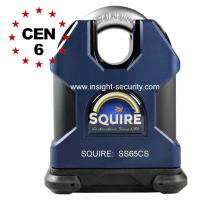 Add My Company
Add My Company
Sign In
Padlock Shackles - What You Need to Know
11-12-2019

Padlocks are available today in a vast range of designs and styles offering various security levels and suitability for all sorts of applications. But all padlocks are fundamentally made up of 3 key elements: the padlock body, the shackle and the locking mechanism. All of these padlock components are important, but in this post we are focusing on the padlock shackle.
Padlock shackles are often targeted by thieves using bolt-croppers or an angle grinder to cut through the metal. So the tougher the padlock shackle, or the more inaccessible it is, then the likelihood of successful attack is minimised.
Padlock Shackle Design
There are a number of different padlock shackle designs, each with varying levels of security and versatility.
Closed Shackle Padlocks
A closed shackle padlock offers only the minimum amount of exposed shackle necessary to secure the padlock. Shoulders on the padlock body enclose the sides of the shackle ensuring they are not available for a would-be thief to grip with some bolt cutters or attack with an angle grinder.
While closed shackle padlocks offer higher security ratings than semi-enclosed and open shackle padlocks they may not be suitable for all applications due to size and clearance limitations. For example, when used with a shrouded hasp or when securing multiple chain links.
Many closed shackle padlocks offer ‘removable shackles’ which are completely released and removable from the padlock body when unlocked.
Semi-Enclosed Shackle Padlocks
As the name suggests, a semi-enclosed shackle padlock offers higher security than an open shackle padlock, but is not as secure as a closed shackle padlock.
Open Shackle Padlocks
Open shackle padlocks are the more familiar form of standard padlock. They are easy and versatile to use, allowing multiple chain links to be locked together. But since the shackle is fully exposed it’s more vulnerable to attack than closed shackle padlocks.
Padlock Shackle Size
The size of the shackle, both in terms of the metal thickness and the overall shackle size are important security factors. The thicker the shackle metal then the more secure the padlock will generally be. For a high security padlock the shackle thickness should be a minimum of 10mm.
Many open shackle padlocks are available with various shackle lengths, allowing them to be used in a variety of applications. But it must always be remembered that the longer the shackle then the more vulnerable the padlock will be.
Another aspect of shackle design that’s been changing in some padlocks is the shackle profile. Traditionally, this has tended to be a round cross section, but some high quality padlock manufacturers are now offering locks with hexagonal shackle cross sections. These provide greater protection against bolt cropper attack.
Padlock Shackle Material
The quality of steel used to manufacture the padlock shackle is obviously important. Cheap padlocks that use low quality steel shackles are easily overcome whereas high quality, high security padlocks that use the best quality, heat-treated steel and alloys are much more secure. Reputable padlock manufacturers go to great lengths to establish a balance between shackle ductility and hardness as these attributes ensure that padlock shackles are less vulnerable to cutting, sawing and shattering.
Hardened alloy steel shackles offer the highest security. The steel alloy shackle is both case hardened, to protect against saw attacks and has a hardened steel core that protects against bolt cropper attack.
Hardened steel shackles are the standard type that’s found on most good quality, general purpose padlocks from reputable manufacturers. Heat treatment is used to case harden the exterior surface of the shackle, making it resistant to saw attacks.
Stainless steel shackles are typically used on weatherproof padlocks designed for exterior and marine applications.
Double Locking Shackles
A double locking shackle means that both ends of the shackle are secured within the padlock body. Cheaper padlocks tend to lock only one end of the padlock shackle which means that if the shackle is cut through in just one place it can be twisted out of the way and overcome. A double locked shackle means that an attack would need to cut through the shackle in two places to release it from the padlock body.
Shackleless Padlocks
Shackleless padlocks are not really shackleless. The shackle is actually completely hidden underneath the padlock body, making them highly resistant to attack and therefore very secure. They tend to be designed for use with specific, matching security hasps. This style of high security padlock has become popular for use on vans and other vehicles where they are used to secure double doors.
For more information on Padlock Shackles - What You Need to Know talk to Insight Security
Enquire Now
List your company on FindTheNeedle.

